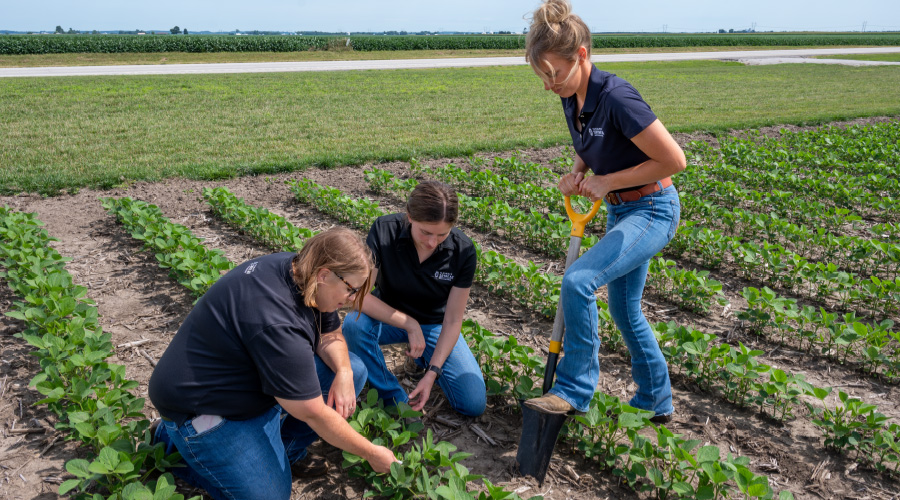Conservation Practices
ABOUT
The core components of conservation management are cover crops, crop rotation, and minimal or no tillage. While they sound simple enough, implementing them on your farm while maintaining crop productivity and profitability is complicated. Research projects in our Conservation Practices category investigate the many aspects associated with adopting these practices so you can reach the conservation goals you set for your farm.
Projects
This project aims to better understand how strategic nutrient management can impact soybean yield across northern and central Illinois. It will evaluate different nutrient strategies under no-till, strip-till, 15” rows, 30” rows, with cover crops, and without cover crops. Data will be used to inform future year trials and ultimately provide farmers with best management practices for nutrient management in soybean crops.
Trials in this multi-year project will help researchers better understand 1) how cereal rye influences nitrogen (N) and sulfur (S) availability and soybean uptake, and 2) evaluate soybean yield response to N and S fertilization, alone and in combination, after a cereal rye cover crop.
This project aims to quantify the benefits of adopting conservation management practices at the field level. This includes how various conservation practices impact crop productivity, greenhouse gas (GHG) emissions, soil carbon sequestration and N leaching/water quality across the various soybean regions in Illinois. Project output will include reports farmers can use to inform their management decisions and help prepare them to take advantage of ecosystem markets, like carbon credit programs.
To help more farmers feel confident implementing conservation tillage systems, this project is investigating the interactions across soil types, starter fertilizer, tillage systems and row spacings and how they affect soybean growth, nutrient uptake, and seed yield and quality. The results will help farmers identify management practices that enable them to plant soybeans into heavy residue while preserving the crop’s yield potential.
This project is comparing 1) different cereal rye seeding dates and rates before soybean, and 2) different planting dates of two clover species after soybean harvest and ahead of corn. Farmers will gain better insights into cover crop planting and seeding rate recommendations and best management practices for adding cover crops to their cropping systems.
This project is collecting soil health, water quality and climate footprint metrics across the state’s growing regions and cropping systems (soy-corn, double-crop wheat-soy with corn rotations). It will help inform practice-based recommendations that protect soil health and water quality, as well as provide insights farmers can use as they explore ecosystem credit programs.
Crop residue is a source of nutrients for the following season’s crop, but it has yet to be documented just how much of which nutrients the residue provides. This project will track the release of nitrogen (N), potassium (K) and sulfur (S) from corn, wheat and cereal rye (as a cover crop) residue for soybean uptake. It will also assess how tillage and biologicals influence nutrient release (how fast and how much) from residue for soybean uptake.
When faced with non-point nutrient loss reduction goals, it truly does take a village. Farmer-led watershed groups are critical to drive cover crop adoption in watershed hot spot areas. Through this project, researchers will use historic and current water quality and conservation practice data for the Lake Bloomington and Evergreen Lake watersheds to conduct a “Nutrient Loss Risk Analysis” that pinpoints high and low risk nutrient-loss zones. They will share the high-risk hot spots with farmer-led watershed groups and agencies, as well as deliver educational resources to help area farmers adopt cover crops and other practices to mitigate nutrient loss.
Can following the MRTN approach reduce tile nitrate loss in conventional and cover cropping systems?
Based on year 1 insights, this year 2 project will focus on validating the maximum return to nitrogen (MRTN) approach as a viable method to determine N rates for corn in a corn/soybean rotation both with and without cover crops. This is particularly important in the tiled fields of central Illinois where it is critical to reduce nitrate loss.
Develop integrated weed management strategies that combine cover crops, herbicides, and tillage to control herbicide-resistant waterhemp, protect soybean yields, and support long-term sustainability.
Compare how different cover crop species and mixtures, combined with two termination timings, affect corn and soybean performance in rotation to help refine regional recommendations for farmers and advisors.
Evaluate the effectiveness of PRE and POST herbicide programs, with and without cereal rye, for weed control in early planted no-till soybeans to help farmers maintain yield and manage resistance under tight application windows.
Waterhemp continues to be one of the most troublesome weeds in Illinois soybean production, with new cases of resistance making management even more difficult. While past research has helped guide strategies for glyphosate resistance, less is known about how to slow the spread of nontarget-site resistance. By identifying which management practices—such as crop rotation, herbicide mixtures, tillage, or cover crops—are most effective, this project will give farmers science-based recommendations to preserve herbicide effectiveness, protect yields, and keep waterhemp in check.
Are you a farmer or advisor?
If you’re a farmer or advisor, we invite you to take our Growing Concerns Survey linked below to help guide future ISA research efforts. We also encourage you to contact us below with specific production challenge research ideas.
Are you a researcher?
If you’re a researcher interested in working with ISA on a project, we encourage you to contact us with your ideas. The RFP will open in early March. Contact us below to be added to the mailing list for more information.
Interested in learning more about this and other topics?
The research archive isn’t the only place to learn about the latest developments in soybean production. Check out the online library for a variety of information about topics that matter to you.

Interested in learning more about this and other topics?
Visit the Online Library to learn more about related projects and more!


 and then
and then